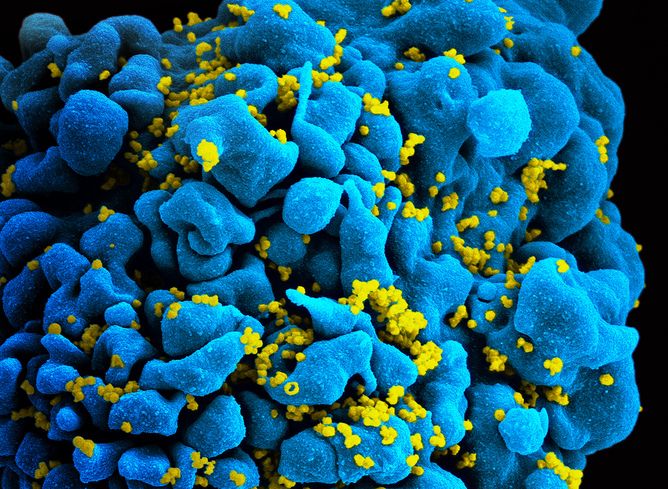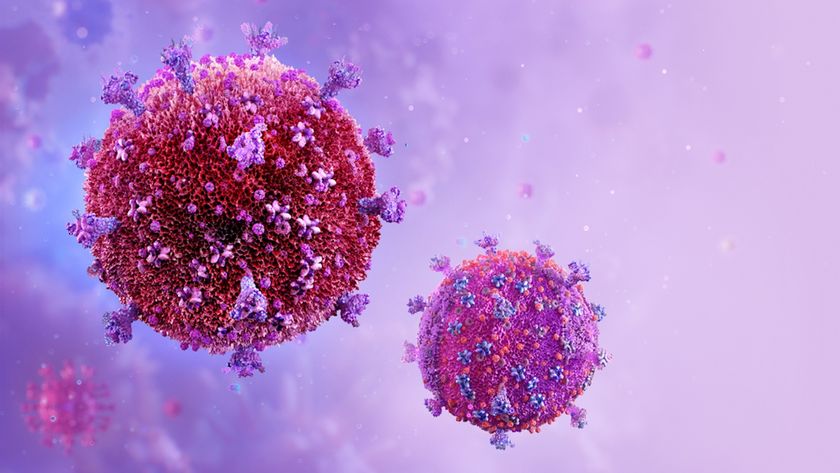
How HIV Co-Opts Gut Bacteria (Op-Ed)

This article was originally published at The Conversation. The publication contributed the article to Live Science's Expert Voices: Op-Ed & Insights.
One of the most effective methods used by HIV to evade control is to hide from the immune system. We’re getting to know much more about how the virus does this and research has revealed how normal bacteria in the intestines – known as gut flora – play a crucial role in thwarting an initial attack mounted by the body’s immune system.
The “good” bacteria in the gut, which we hear so much about, are there to keep us healthy. They are kept in check by a pool of “naive B” (white blood) cells, which retain a pool of “memory” B cells that produce consistently low numbers of antibodies to control overall bacterial numbers.
These naive B cells are also crucial for controlling new infections. When these cells encounter a new infection, they produce specific antibodies to attack it, which coat the surface of infected cells and tag them for destruction. But according to a study from Duke Medicine, published in Cell Host & Microbe, when HIV enters and begins replicating in the gut, the reaction of B cells is ineffective because the virus is able to pose as a “good” bacteria.
Molecular mimicry
So how does this work? The researchers discovered that HIV evades the B cell immune response by mimicking the bacteria on a molecular level. On the surface of HIV is a protein called gp41, which makes up the envelope surrounding the crucial elements of the virus. When the virus invades, this protein ends up on the surface of human cells and it is this that B cells would ordinarily target.
However, HIV has evolved to make gp41 look very similar on a molecular level to proteins found on the surface of gut bacteria. So, the B cells don’t try to produce antibodies against HIV-infected cells because their “memory” tells them that the low levels of antibodies they produce to manage bacteria is enough. The overall result is that instead of a large immune response being mounted against the infection, the memory B cell pool takes precedent and only a weak immune response occurs against the virus.
This work suggests that the gut flora might play a larger role than previously thought in determining our reaction to HIV, and possibly other infections.
Sign up for the Live Science daily newsletter now
Get the world’s most fascinating discoveries delivered straight to your inbox.
Genetic differences influence HIV vaccine
The discovery about how HIV can hide in plain sight in this way comes alongside new data on its response to a new vaccine called RV144, which showed some success (31% efficacy) in a large clinical trial in Thailand. HIV easily mutates very readily and the virus has different strains, which can be carried by one infected person. The aim of the RV144 vaccine is to stimulate the production of broadly neutralising antibodies, which are antibodies that will work on these multiple strains of HIV (rather than only working on individual strains).
Building on the Thai study, another piece of research published in the Journal of Clinical Investigation showed that genetic differences between adults had a significant effect on whether RV144 had a protective effect. Specifically, the authors showed that the vaccine only protected individuals with a specific form of a gene called FCGR2C. This gene encodes a receptor on the surface of B cells which can recognise HIV-infected cells that have been coated with antibodies, and which sends signals to activate B cells. Having this specific form of the gene, then, results in an increase in immune activity.
What does this mean? Well it suggests that genetic differences in immune system genes between individuals could predict how successful a vaccine will be, and researchers developing this vaccine (and other potentials) will have to take these differences into account if they’re to get to the next level.
HIV: the master of disguise
With HIV hiding in the gut – posing as a different entity and thwarting antibodies – along with its already well known ability to rapidly mutate to avoid detection, low rates of success of potential vaccines and the newly identified genetic reasons for why, it’s clear that producing a universal vaccine against HIV that works by stimulating antibody production is a tall order.
This isn’t to say that it is not still a necessary route of research. Current treatment using anti-retrovirals has many of its own issues, including the expense of using them and the potential toxicity of long term use.
We are still probably many years away from a vaccine against HIV, but with each new clinical trial and study we fit together another piece of a complex puzzle about how it infects and evades. Both the Duke study and the Thai vaccine study have moved us forward by a large step, and hopefully will drive further work towards a successful vaccine.
Kathryn Lagrue does not work for, consult to, own shares in or receive funding from any company or organisation that would benefit from this article, and has no relevant affiliations.
This article was originally published on The Conversation. Read the original article. Follow all of the Expert Voices issues and debates — and become part of the discussion — on Facebook, Twitter and Google +. The views expressed are those of the author and do not necessarily reflect the views of the publisher. This version of the article was originally published on Live Science.













